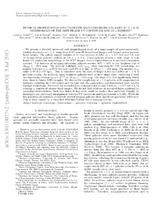| dc.description.abstract | We present a detailed structural and morphological study of a large sample of spectroscopicallyconfirmed
galaxies at z ≥ 6, using deep HST near-IR broad-band images and Subaru optical narrowband
images. The galaxy sample consists of 51 Ly_ emitters (LAEs) at z ≃ 5.7, 6.5, and 7.0, and
16 Lyman-break galaxies (LBGs) at 5.9 ≤ z ≤ 6.5. These galaxies exhibit a wide range of restframe
UV continuum morphology in the HST images, from compact features to multiple component
systems. The fraction of merging/interacting galaxies reaches 40% ∼ 50% at the brightest end of
M1500 ≤ −20.5 mag. The intrinsic half-light radii rhl,in, after correction for PSF broadening, are
roughly between rhl,in ≃ 0.′′05 (0.3 kpc) and 0.′′3 (1.7 kpc) at M1500 ≤ −19.5 mag. The median rhl,in
value is 0.′′16 (∼0.9 kpc). This is consistent with the sizes of bright LAEs and LBGs at z ≥ 6 in
previous studies. In addition, more luminous galaxies tend to have larger sizes, exhibiting a weak
size-luminosity relation rhl,in ∝ L0.14 at M1500 ≤ −19.5 mag. The slope of 0.14 is significantly flatter
than those in fainter LBG samples. We discuss the morphology of z ≥ 6 galaxies with nonparametric
methods, including the CAS system and the Gini and M20 parameters, and demonstrate their validity
through simulations. We search for extended Ly_ emission halos around LAEs at z ≃ 5.7 and 6.5, by
stacking a number of narrow-band images. We do not find evidence of extended halos predicted by
cosmological simulations. Such Ly_ halos, if they exist, could be weaker than predicted. Finally, we
investigate any positional misalignment between UV continuum and Ly_ emission in LAEs. While the
two positions are generally consistent, several merging galaxies show significant positional differences.
This is likely caused by a disturbed ISM distribution due to merging activity. | en_US |

